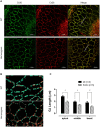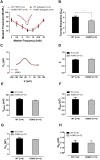Hearing consequences in Gjb2 knock-in mice: implications for human p.V37I mutation
- PMID: 31562289
- PMCID: PMC6782001
- DOI: 10.18632/aging.102246
Hearing consequences in Gjb2 knock-in mice: implications for human p.V37I mutation
Abstract
Human p.V37I mutation of GJB2 gene was strongly correlated with late-onset progressive hearing loss, especially among East Asia populations. We generated a knock-in mouse model based on human p.V37I variant (c.109G>A) that recapitulated the human phenotype. Cochlear pathology revealed no significant hair cell loss, stria vascularis atrophy or spiral ganglion neuron loss, but a significant change in the length of gap junction plaques, which may have contributed to the observed mild endocochlear potential (EP) drop in homozygous mice lasting lifetime. The cochlear amplification in homozygous mice was compromised, but outer hair cells' function remained unchanged, indicating that the reduced amplification was EP- rather than prestin-generated. In addition to ABR threshold elevation, ABR wave I latencies were also prolonged in aged homozygous animals. We found in homozygous IHCs a significant increase in ICa but no change in Ca2+ efficiency in triggering exocytosis. Environmental insults such as noise exposure, middle ear injection of KCl solution and systemic application of furosemide all exacerbated the pathological phenotype in homozygous mice. We conclude that this Gjb2 mutation-induced hearing loss results from 1) reduced cochlear amplifier caused by lowered EP, 2) IHCs excitotoxicity associated with potassium accumulation around hair cells, and 3) progression induced by environmental insults.
Keywords: GJB2; age-related hearing loss; environmental stress; hair cells; potassium recycling.
Conflict of interest statement
Figures












Similar articles
-
Characterization of a knock-in mouse model of the homozygous p.V37I variant in Gjb2.Sci Rep. 2016 Sep 13;6:33279. doi: 10.1038/srep33279. Sci Rep. 2016. PMID: 27623246 Free PMC article.
-
Generation and characterization of a humanized GJB2 p.V37I knock-in mouse model for studying age-related hearing loss.Drug Discov Ther. 2025 May 9;19(2):103-111. doi: 10.5582/ddt.2025.01023. Epub 2025 Apr 28. Drug Discov Ther. 2025. PMID: 40301096
-
The Relationship between the p.V37I Mutation in GJB2 and Hearing Phenotypes in Chinese Individuals.PLoS One. 2015 Jun 10;10(6):e0129662. doi: 10.1371/journal.pone.0129662. eCollection 2015. PLoS One. 2015. PMID: 26061099 Free PMC article.
-
Association between the p.V37I variant of GJB2 and hearing loss: a pedigree and meta-analysis.Oncotarget. 2017 Jul 11;8(28):46681-46690. doi: 10.18632/oncotarget.17325. Oncotarget. 2017. PMID: 28489599 Free PMC article. Review.
-
Connexins, hearing and deafness: clinical aspects of mutations in the connexin 26 gene.Brain Res Brain Res Rev. 2000 Apr;32(1):159-62. doi: 10.1016/s0165-0173(99)00075-2. Brain Res Brain Res Rev. 2000. PMID: 10928803 Review.
Cited by
-
Hearing Phenotypes of Patients with Hearing Loss Homozygous for the GJB2 c.235delc Mutation.Neural Plast. 2020 Aug 1;2020:8841522. doi: 10.1155/2020/8841522. eCollection 2020. Neural Plast. 2020. PMID: 32802038 Free PMC article.
-
Deficient Gap Junction Coupling in Two Common Hearing Loss-Related Variants of GJB2.Clin Exp Otorhinolaryngol. 2024 Aug;17(3):198-205. doi: 10.21053/ceo.2023.00078. Epub 2024 Jun 4. Clin Exp Otorhinolaryngol. 2024. PMID: 38831582 Free PMC article.
-
Disruption of Hars2 in Cochlear Hair Cells Causes Progressive Mitochondrial Dysfunction and Hearing Loss in Mice.Front Cell Neurosci. 2021 Dec 15;15:804345. doi: 10.3389/fncel.2021.804345. eCollection 2021. Front Cell Neurosci. 2021. PMID: 34975414 Free PMC article.
-
Analysis of GJB2 gene mutations spectrum and the characteristics of individuals with c.109G>A in Western Guangdong.Mol Genet Genomic Med. 2023 Aug;11(8):e2185. doi: 10.1002/mgg3.2185. Epub 2023 Apr 18. Mol Genet Genomic Med. 2023. PMID: 37070846 Free PMC article.
-
Interactions of genetic variations in FAS, GJB2 and PTPRN2 are associated with noise-induced hearing loss: a case-control study in China.BMC Med Genomics. 2024 Jan 11;17(1):18. doi: 10.1186/s12920-023-01790-7. BMC Med Genomics. 2024. PMID: 38212800 Free PMC article.
References
-
- Fortnum HM, Summerfield AQ, Marshall DH, Davis AC, Bamford JM, Davis A, Yoshinaga-Itano C, Hind S. Prevalence of permanent childhood hearing impairment in the United Kingdom and implications for universal neonatal hearing screening: questionnaire based ascertainment study. BMJ. 2001; 323:536–40. 10.1136/bmj.323.7312.536 - DOI - PMC - PubMed
-
- Zelante L, Gasparini P, Estivill X, Melchionda S, D'Agruma L, Govea N, Mila M, Monica MD, Lutfi J, Shohat M, Mansfield E, Delgrosso K, Rappaport E, et al.. Connexin26 mutations associated with the most common form of non-syndromic neurosensory autosomal recessive deafness (DFNB1) in Mediterraneans. Hum Mol Genet. 1997; 6:1605–09. 10.1093/hmg/6.9.1605 - DOI - PubMed
Publication types
MeSH terms
Substances
LinkOut - more resources
Full Text Sources
Molecular Biology Databases
Miscellaneous

